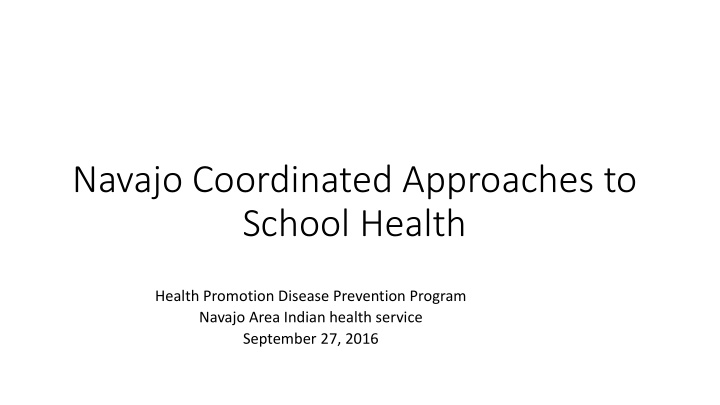



Navajo Coordinated Approaches to School Health Health Promotion Disease Prevention Program Navajo Area Indian health service September 27, 2016
Welcome and Introduction • Marie Nelson, Coordinator, HPDP, Navajo Area Indian Health Service • Carol Leonard, Health Promotion Specialist, Navajo Area Indian Health Service
Navajo Area Wide HPDP Program Service Population Geographical Area • Located in the Southwest Region • Primarily Navajo Population • Navajo Area spans 3 states of Arizona, • On Navajo 300,000+ New Mexico and Utah • Off Navajo (Border Towns, Major Cities • Provide services in 5 counties of 3 states • Rural, remote and culturally distinct
4
Navajo Area wide Schools Various Types of Schools • Bureau Of Indian Education • Public Schools • Community/Grant Schools/ • Private • Parochial
Navajo Coordinated Approaches to School Health Initiated in 1997 as Coordinated Approaches to School Health (CASH) using Special Diabetes Program for Indians (SDPI) Funds In 2010, CASH was revised based upon an assessment and new SDPI key measures Since 2010, the Navajo Coordinated Approaches to School Health (NCASH) Project began with following key measures:
Project Background • 7th year of implementation of the new approaches developed under the NCASH Project • 64 schools participated in the NCASH Project from SY 2010 -2011 to 2015-2016 SY 2010-11 SY 2011-12 SY 2012-13 SY 2013-14 SY 2014-15 SY 2015-16 Year 1 Year 2 Year 3 Year 4 Year 5 Year 6 Total number of schools 24 21 31 31 19 19 Total number of students 6,433 5,923 8,834 7,217 4,444 3,995 SY=School Year
Key Measures • Capacity: Schools will increase their capacity to implement and evaluate evidence-based programs that have been shown to reduce the risk of diabetes. • Physical Activity: Schools will increase the number of students who participate in at least 150 minutes per week of physical activity. • Diabetes Education: Schools will increase the number of students receiving culturally specific diabetes prevention education.
Key Measures (cont’d) • School Environment and Policy: Schools will improve policies and environment supportive of healthy eating and physical activity behaviors using the School Health Index, Local School Wellness Policy and School Improvement Plan. • Family and Community Involvement: Schools will increase the number of diabetes prevention activities to students, their families and community members to improve healthy eating and increase physical activity. • Sustainability: Diabetes prevention activities will be sustained by the schools to improve healthy eating and physical activity behaviors for students.
NCASH at work against obesity SY 2010-11 (Year 1) SY 2011-12 (Year 2) SY 2012-13 (Year 3) SY 2013-14 (Year 4) SY 2014-15 (Year 5) SY 2015-16 (Year 6) Underweight 2% 3% 3% 2% 2% 5% 53% 55% 51% 51% 51% 51% Normal Weight Overweight 23% 18% 24% 29% 23% 25% 25% 25% 23% 21% 24% 19% Obese
Policy Tribal Leadership Regulations Government School Health Local Wellness Index COMMUNITY Plans Grocery Stores/ Community Group/Organizations Laws Trading Post Farm Boards/Ranches ORGANIZATIONAL Wellness Centers School Improvement Plan Schools Health Care Staff INTERPERSONAL Wellness Navajo Nation Family Involvement INDIVIDUAL Student
The Core of NCASH Capacity Building Systemic Changes Setting Cultural Standard in Educational Institutions Policies Aligned with Diné Philosophy
Recommend
More recommend